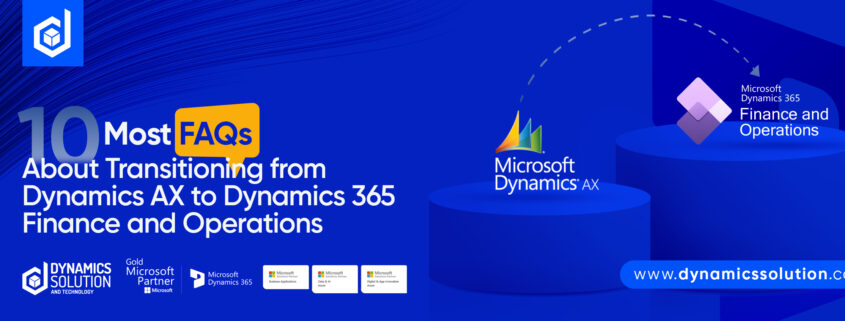The process of migrating from Dynamics AX to Dynamics 365 Finance and Operations can present a challenging and formidable task. However, it’s also a necessary step to leverage the advanced capabilities, enhanced flexibility, and future-proof technology that Dynamics 365 offers.
To help you navigate this transition, we’ve compiled answers to the ten most frequently asked questions about moving to Dynamics 365 Finance and Operations.
Why Should You Upgrade from Dynamics AX to Dynamics 365 Finance and Operations?
Upgrade offers numerous benefits, including enhanced functionality, improved user experience, and integration with other Microsoft services. Dynamics 365 provides advanced analytics, AI-driven insights, and a cloud-based architecture that ensures scalability and accessibility. It means you’ll stay ahead of the curve with a future-proof ERP system that adapts to your evolving business needs.
What Are the Key Differences Between Dynamics AX and Dynamics 365 Finance and Operations?
F&O is built on a modern, cloud-based architecture, unlike AX, which is primarily on-premises. The new system offers improved scalability, accessibility, and security.
Additionally, Dynamics 365 integrates seamlessly with other Microsoft services like Office 365, Power BI, and Azure, providing a unified ecosystem. It also includes enhanced features like:
- Advanced analytics
- AI capabilities
- An intuitive user interface.
How Long Does the Transition Process Take?
The timeline for transition can vary depending on the complexity of your current system and business processes. On average, the transition can take anywhere from a few months to over a year.
Factors influencing the timeline include:
- Data migration
- Customization requirements
- User training
- Testing
What Are the Costs Involved in Transitioning to Dynamics 365 Finance and Operations?
Costs associated with transition can include licensing fees, implementation services, data migration, customization, and training. While the initial investment may be significant, the long-term benefits of improved efficiency, scalability, and reduced infrastructure costs often outweigh these expenses.
How Can You Ensure Data Integrity During the Transition?
Start by conducting a thorough data audit to identify and clean up any inconsistencies in your current system. Use robust data migration tools and methodologies to transfer data accurately. It’s also essential to perform comprehensive testing and validation to ensure all data is correctly migrated and functioning as expected in the new system.
What Steps Should You Take to Prepare for the Transition?
You can follow the following steps:
- Begin by assessing your current system and identifying areas that need improvement.
- Develop a detailed project plan that outlines the transition timeline, key milestones, and resource allocation.
- Engage stakeholders from various departments to gather requirements and ensure alignment with business goals.
- Invest in training and change management to prepare your team for the new system.
How Will the Transition Affect Your Day-to-Day Operations?
During the transition, there may be some disruptions to your day-to-day operations. To minimize this impact, consider implementing the transition in phases, allowing certain functions to continue operating on the old system while others are migrated to F&O. However, effective communication and support are crucial to address any issues promptly and ensure a smooth transition for all users.
What Are the Customization Capabilities of Dynamics 365 Finance and Operations?
The platform allows you to customize workflows, reports, and user interfaces. Additionally, it supports extensions and integrations with third-party applications, enabling you to tailor the system to your specific requirements.
Microsoft’s AppSource marketplace also offers a wide range of pre-built solutions that can enhance functionality.
How Do You Train Your Team on Dynamics 365 Finance and Operations?
Start by identifying key users and providing them with in-depth training on Dynamics 365 Finance and Operations. Utilize a mix of training methods, including online courses, hands-on workshops, and documentation. Encouraging a culture of continuous learning and providing ongoing support will help your team adapt to the new system and leverage its full potential.
How Do You Choose the Right Implementation Partner?
Look for a partner with a proven track record of successful Dynamics 365 implementations and industry expertise. Evaluate their technical skills, project management capabilities, and customer references. A good partner will offer end-to-end services, from initial assessment and planning to implementation, training, and support, ensuring a seamless transition and ongoing success.
Wrap Up!
Transitioning from Dynamics AX to Dynamics 365 Finance and Operations is a strategic move that can significantly enhance your business operations. By addressing common questions and concerns, we hope to provide you with the knowledge and confidence needed to embark on this journey.
To ensure a smooth and successful transition, it’s essential to partner with experts who understand your unique business needs. Dynamics Solution and Technology is here to serve. With a proven track record and comprehensive services, we can guide you through every step of the process, from planning and implementation to training and support. Contact us today to learn more about how we can make your migration smoother without losing data.






